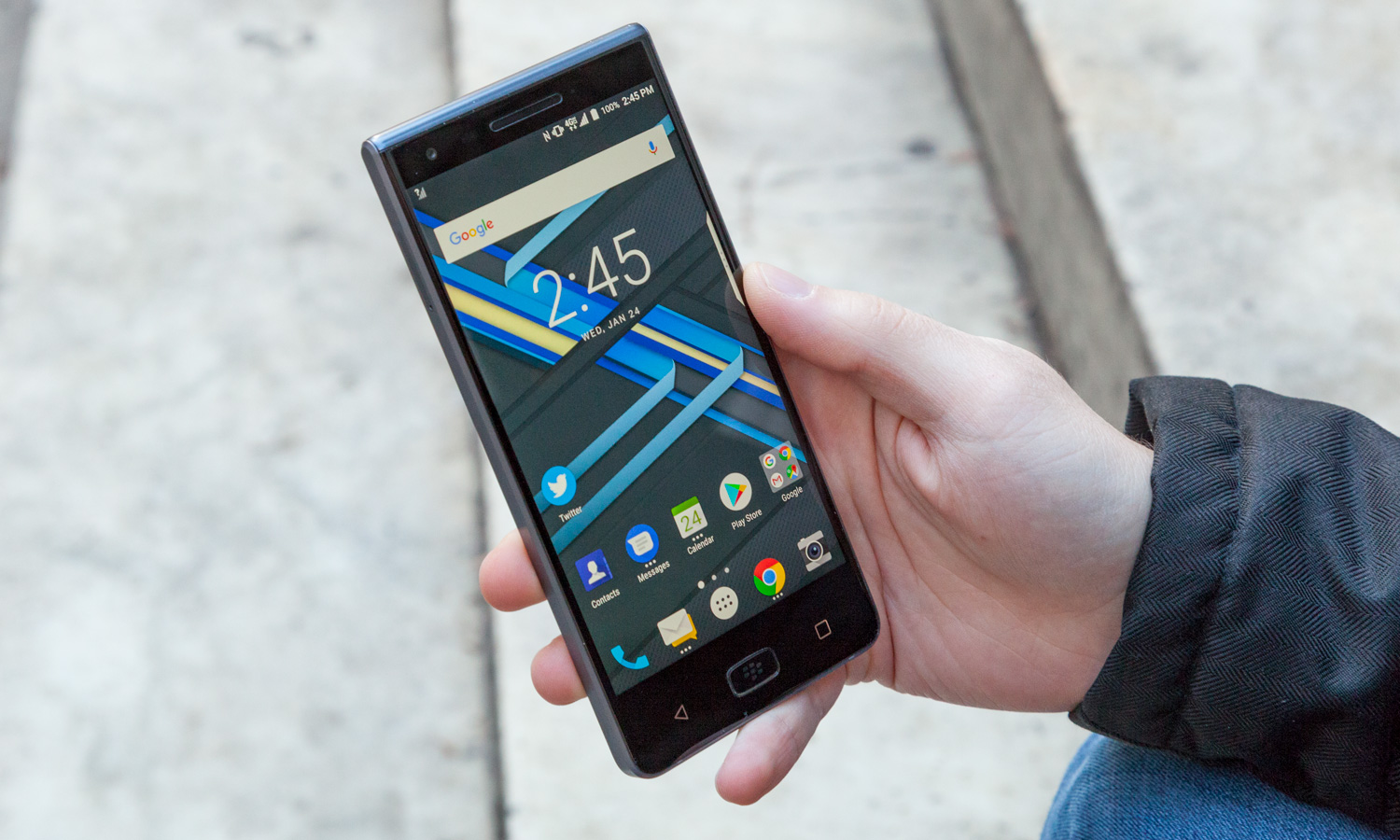Tom's Guide Verdict
BlackBerry's latest Android smartphone opts for a bigger screen instead of a physical keyboard, but brings the same focus on productivity and security.
Pros
- +
Secure
- +
Long battery life
- +
Helpful software for productivity users
- +
Great display
Cons
- -
Expensive relative to comparable phones
- -
Bulky, boring design
- -
Underwhelming specs
Why you can trust Tom's Guide
There's a recurring theme with BlackBerry's smartphones in recent years, one that the brand hasn't been able to shake since it transitioned to Android.
BlackBerry's latest devices, built under license by TCL, have been secure and sturdy, with exclusive software features designed to help you get things done faster. Some, like the BlackBerry KeyOne, have even improved on the physical keyboard with gesture support and a space bar that doubles as a fingerprint sensor. But recent BlackBerry phones have also been on the expensive side, despite middle-of-the-road specs.
TCL is following the KeyOne with another secure, sturdy smartphone, this time for those of us who don't demand physical keyboards. And once again, it isn't cheap: the BlackBerry Motion starts at $449, putting it in the same price range as the OnePlus 5T, the Essential Phone and the Moto X4. After years of lagging behind the pack, will this be the BlackBerry that finally rises to the occasion?
Price and Availability
The BlackBerry Motion comes in a single $449 configuration. For that money, you get 32GB of internal storage and an unlocked device that is compatible only with GSM networks, such as AT&T, T-Mobile, Cricket and MetroPCS. If you need more space, there is a microSD slot that can carry up to an additional 2TB.
MORE: BlackBerry Motion Debuts, But More Keyboard Phones Coming
Design: It's a BlackBerry, All Right
When critics call most smartphones nondescript black slabs, they're talking about devices like the BlackBerry Motion. True, there are little touches all around the handset -- like the soft-touch carbon fiber-effect back panel and chamfered gunmetal frame -- that remind you you're using a serious, business-focused machine for serious, business-focused people. But the phone's not elegant, and compared to many of the devices that passed through our hands last year, it certainly isn't where the industry is headed.
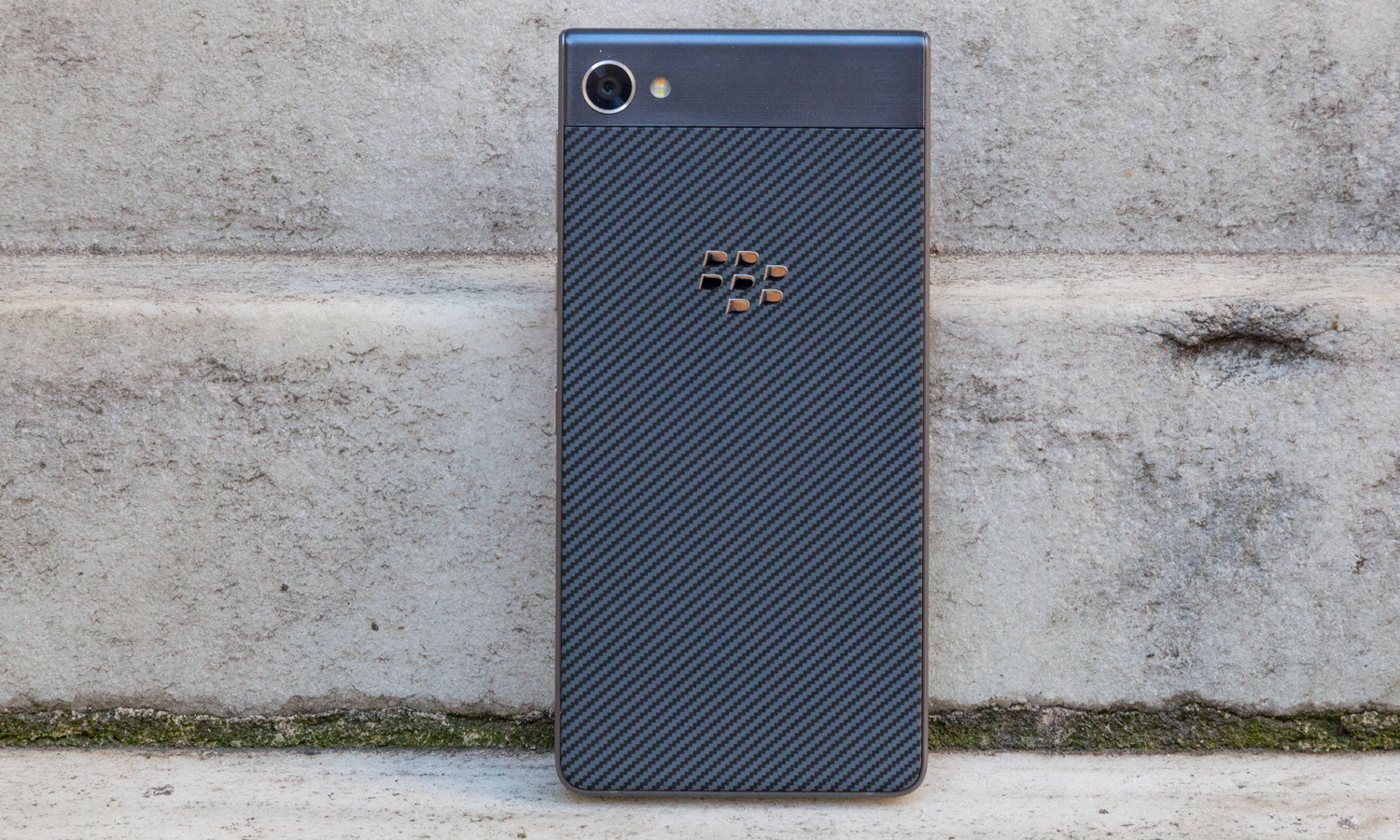
The Motion incorporates a 5.5-inch, full-HD panel and an asymmetrical design. At the top, a strip of plastic loops around the phone in a continuous curve, joining the bezel that contains the earpiece and front-facing camera with the portion on the back that houses the rear camera and flash. The bottom of the frame is not curved, so it's there that you'll find the USB-C port, headphone jack and speaker grille. It's a different look, though I wouldn't call it stylish.
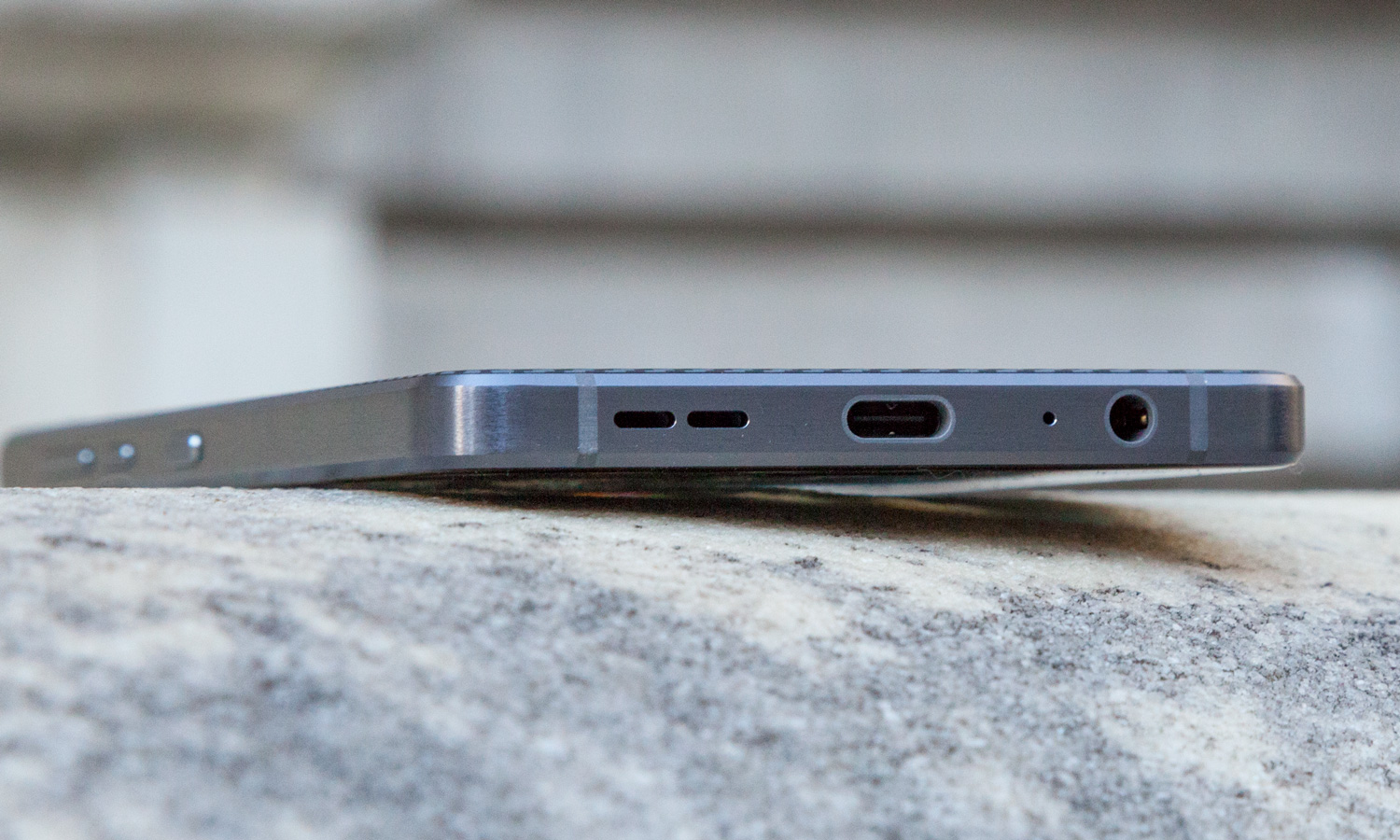
All of the device's keys are stashed on the Motion's right edge, which will inevitably lead to confusion the first time you pick it up. The power button sits very close to the volume rocker, while the slightly larger and textured Convenience Key used for shortcuts stands on its own farther down the side.
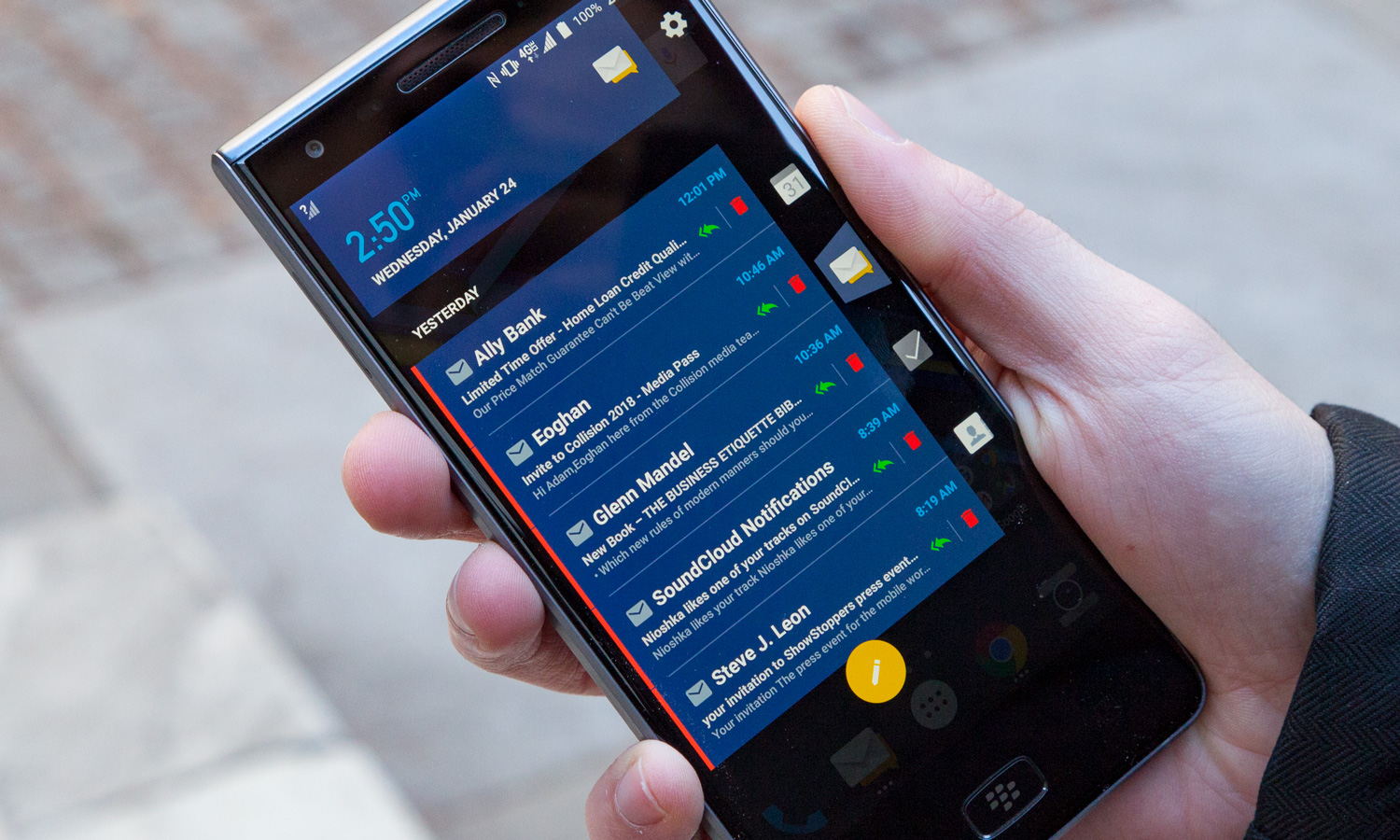
The Convenience Key's more prominent placement and design really make it feel like it should be the power button; if you're anything like me, you'll repeatedly mash that key expecting to wake the phone.
The Motion's bottom bezel would have been dated three years ago.
Those are relatively minor complaints, though, compared to the Motion's eyesore of a bottom bezel. At a time when extraneous surface area is being cropped away wherever possible, this massive chin is comically large. It would have been dated three years ago. I'm not asking for a OnePlus 5T or iPhone X edge-to-edge-style treatment here, but a little trimming would have gone a long way toward making the Motion both easier to hold in one hand and much more attractive compared with its peers.
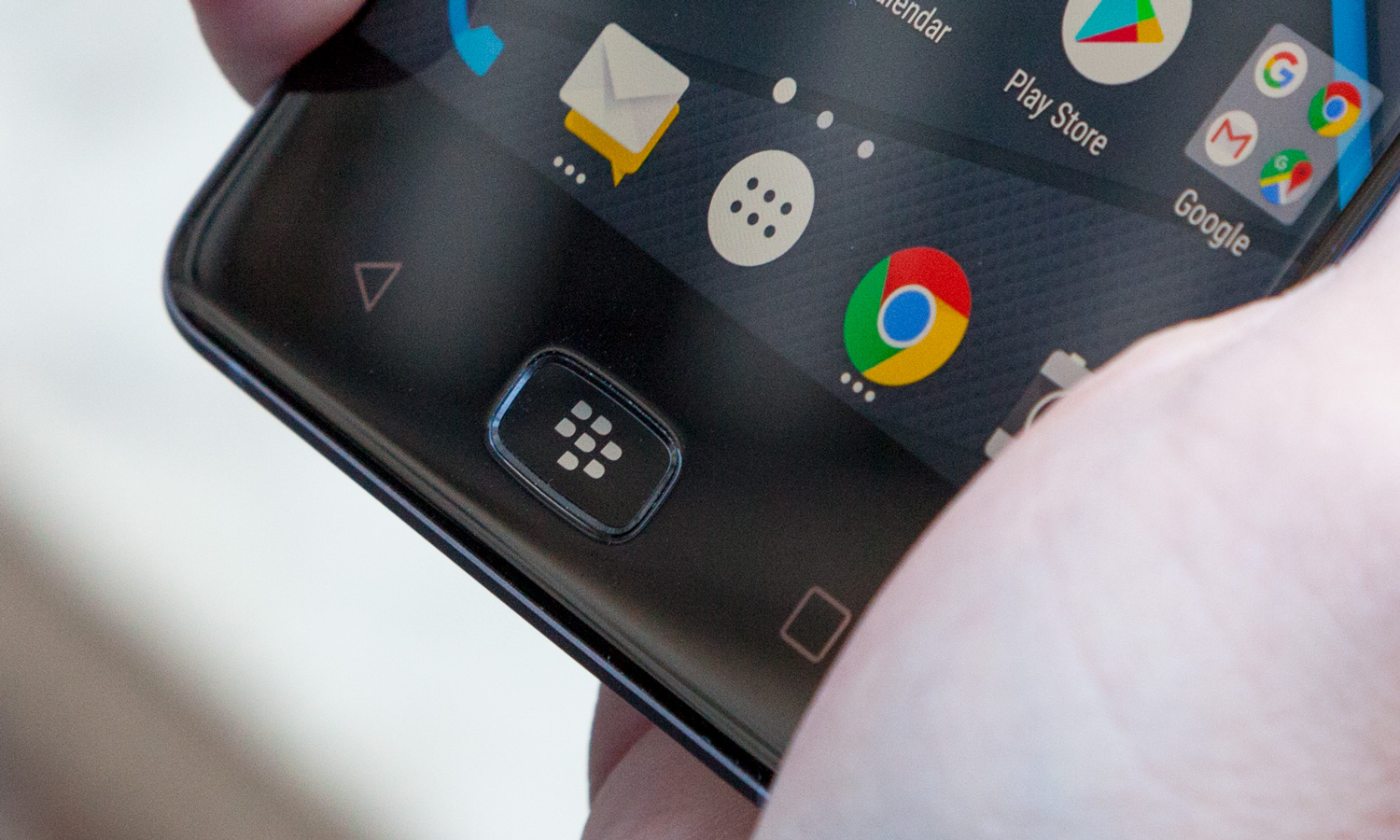
Fortunately, at least the BlackBerry Motion is well-built and water resistant, a first for one of the company's smartphones. The back doesn't feel as premium as the Pixel 2's powder-coated aluminum or the Essential Phone's ceramic, but it is pleasing to the touch. And while the front-mounted fingerprint sensor is a smidge too small, I appreciate that it's a real, physical button. Just make sure you record your prints at the angle you place your thumb when using the phone normally, or else you'll have little success unlocking the phone.
BlackBerry Motion Specs
| Price | $449 |
| OS | Android 7.1.2 Nougat |
| Screen Size (Resolution) | 5.5 inches (1920 x 1080) LCD |
| CPU | Qualcomm Snapdragon 625 |
| RAM | 4GB |
| Storage | 32GB |
| microSD Slot? | Yes, up to 2TB |
| Rear Camera | 12MP (f/2.0) |
| Front Camera | 8MP (f/2.2) |
| Battery Life (Hrs:Mins) | 11:44 |
| Water Resistance | Yes, IP67 |
| Size | 6.13 x 2.97 x 0.32 inches |
| Weight | 5.5 ounces |
Display: Among the Best and Brightest
A 5.5-inch, full-HD LCD display is about what you'd expect in a midrange phone, and sure enough, that's what you get from the Motion. Those details alone don't tell the whole story, however, because the latest BlackBerry's screen also happens to be one of the best you'll find in its class.
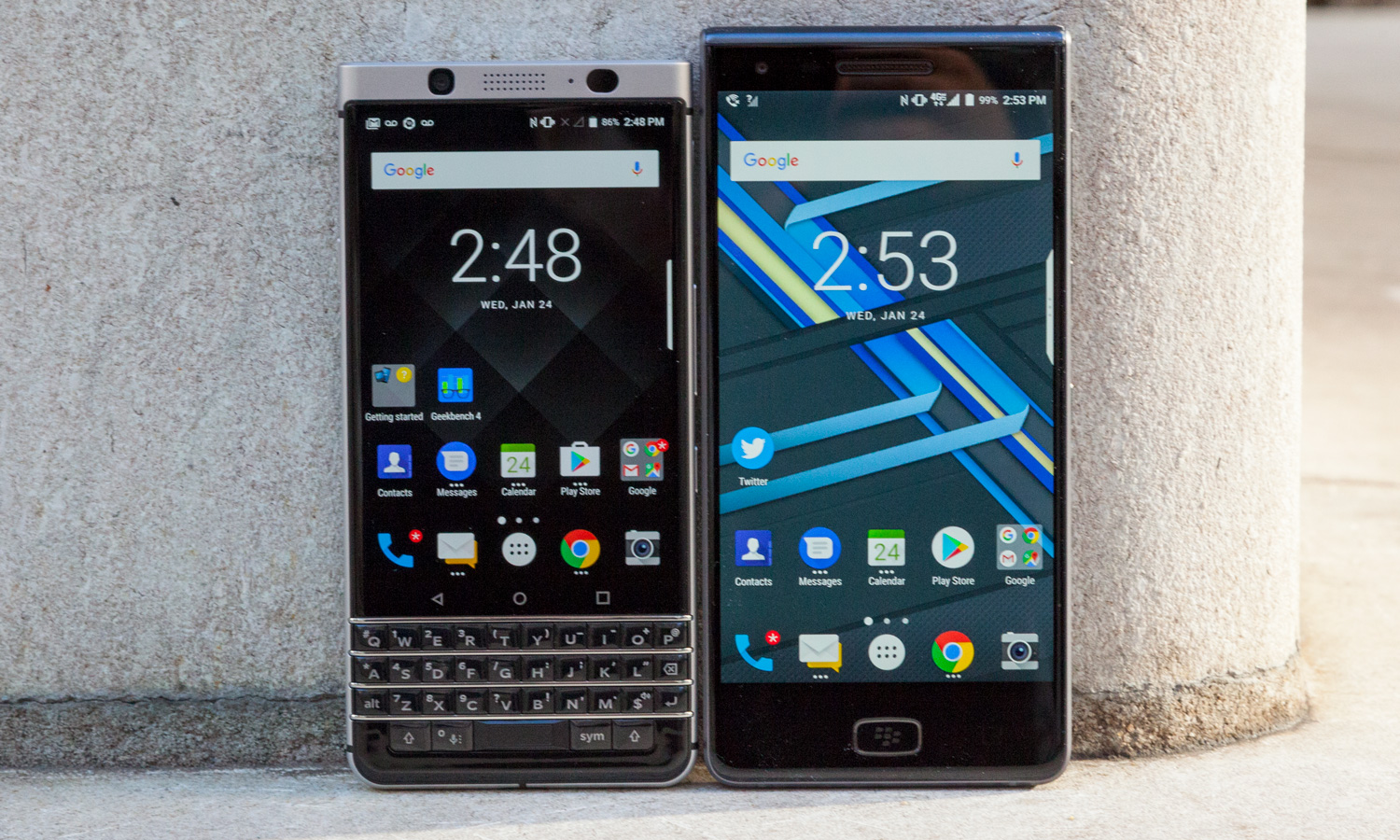
It's also one of the brightest. At a peak full-screen brightness of 520 nits, it's right on par with the 515 nits you get from the excellent 5.2-inch panel in the HTC U11 Life. I really like the way BlackBerry has calibrated the colors, too. Although the Motion's screen isn't the most accurate, with a Delta-E rating of 0.73 (numbers closer to 0 are better), it exhibits a deep range of hues, covering 170.7 percent of the sRGB color space.
The display isn't garishly oversaturated, nor does it come across as dull or washed out. Much like HTC and Motorola's LCD screens, the BlackBerry Motion's strikes the right balance. And that's very fortunate, because the Motion does not offer any alternate-display modes.
Software: Useful Enhancements to Nougat
The Motion may be running an outdated form of Android — version 7.1.2 Nougat, to be specific — though you can't fault BlackBerry for not leaving its mark on the software. The phone benefits from BlackBerry's suite of workflow apps, which actually present sophisticated solutions to common problems in a few cases.
BlackBerry's Android devices typically feature an additional UI layer known as the Productivity Tab, which has returned here. It lives on either the right or left side of the display, similar to the Edge Panel on Samsung's handsets, and functions almost like a widget that aggregates all your emails, messages and social media notifications, while offering shortcuts to your tasks and calendar as well.
If that sounds overwhelming, it can be; the Productivity Tab won't be for everyone. But if you're managing a corporate Twitter while pinging co-workers in Slack and fielding emails, it can prove its worth. I will readily admit I don't keep as close an eye on my emails as I probably should, but I appreciate that the Productivity Tab ensures all of my recent conversations are never more than a swipe away.
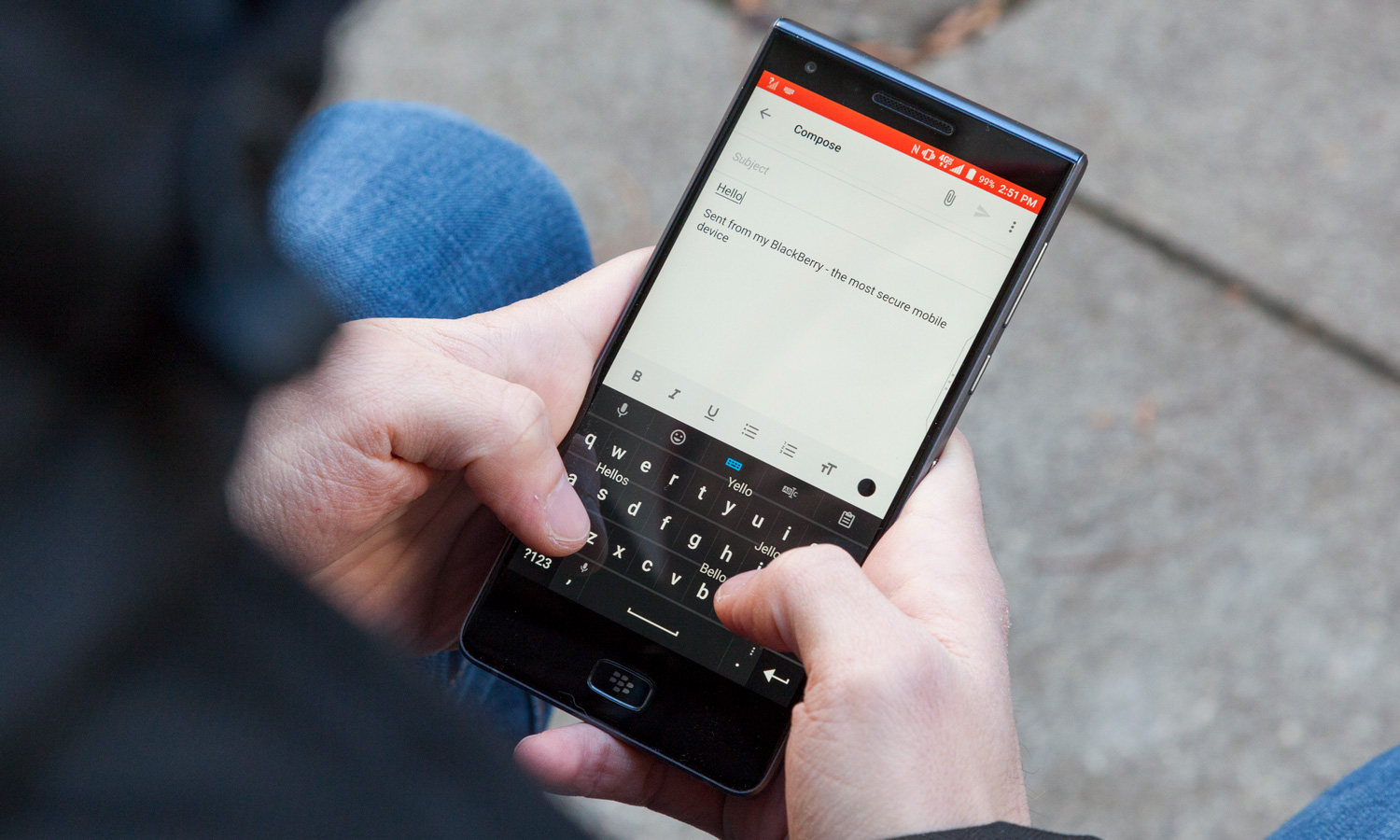
There's also the Motion's innovative digital keyboard, which delivers predictive text in an unusual but effective way. As you type, auto-complete words will appear above letters. To use one of the suggestions, simply swipe up on the associated key. It can be quite overwhelming to see so much noise on the typing surface, but it also opens you up to more than three suggestions at a time, and puts them in your line of sight, which likely means you're more likely to use them.
The latest BlackBerry's screen happens to be one of the best you'll find in its class.
Although you won't find a physical keyboard on the Motion, BlackBerry has preserved one critical button from the KeyOne: the Convenience Key. Press it, and you're presented with shortcuts to various apps and tasks. You can even program the key to display different shortcuts depending on context — whether you're in the car, connected to a specific Wi-Fi network, or in the middle of a meeting you've recorded on your calendar.
MORE: The Best Android Phones You Can Buy Right Now
Like Alcatel's Boom Key or LG's Quick Button on its X Venture, the Convenience Key is, well, convenient. However, BlackBerry missed an obvious opportunity to let users hold or double-tap the button for secondary commands. Instead, the Convenience Key only responds to single presses, and forces you to make another tap on screen after that to select the shortcut out of a list of three. It's an unnecessary step that almost negates the purpose, and very odd, considering the KeyOne recognizes long and short presses on its keyboard shortcuts — so it's not like this isn't something BlackBerry hasn't made available elsewhere.
Security: One of the Most Secure Android Phones
Regarding security, many of the Motion's unique features are housed inside the DTEK app. BlackBerry is very diligent about making sure its devices are always running Google's latest security patch, but DTEK is as much about educating users to make informed decisions as it is about preventing discreet attacks.
One of the DTEK's useful considerations for security-minded owners is the way it monitors apps for abusing permissions. For example, tap on Chrome in the DTEK app, and it will show you all the times Google's browser pinged your location, called up your camera, or started recording from your microphone. It'll break down each location event, and drop a pin on a map precisely where it took place.
It's fascinating to see all this information provided so transparently, but ultimately, if you determine a rogue app needs to be curtailed, you'll be whisked back to the stock Android settings menu to turn off those pesky permissions. In those situations, DTEK can feel like little more than window dressing. But BlackBerry's approach to security actually goes much deeper than that, starting at the manufacturing level.
The DTEK security app is as much about education as it is prevention.
Like the KeyOne, and the Priv before it, DTEK is series of phones, with the processor inside the Motion bolstered by cryptographic keys that are checked against the firmware upon startup along with BlackBerry's servers, ensuring authenticity. A stronger and continuously updated Linux kernel as well as a bespoke bootloader have made BlackBerry's phones notoriously difficult to root — something that can't be said for the majority of Android phones.
Battery: BlackBerry's Biggest, But Not its Longest Lasting
The Motion comes equipped with the largest battery ever in a BlackBerry device, at 4,000 mAh. The last of the company's handsets we tested, the KeyOne, managed to last nearly 13 hours in our testing on a smaller 3,505-mAh pack — so if anything we expected to see better longevity here.
Surprisingly, the Motion lasted for 11 hours and 44 minutes when we ran it through our battery test, which consist of continuous web surfing on T-Mobile LTE. A result in the neighborhood of 12 hours is still very strong, though a little surprising given the size of the Motion's battery.
MORE: Smartphones with the Longest Battery Life
For example, the Pixel 2 XL, with its remarkably sharp OLED display and processor tuned for performance rather than efficiency, bested the Motion at 12 hours and 9 minutes despite having a battery about the same size as the KeyOne's. And the $199 Asus ZenFone 4 Max, featuring one of the largest batteries we've tested at 5,000 mAh, delivered nearly 15.5 hours.
Powered by Qualcomm's QuickCharge 3.0 system, the phone reached 30 percent in the first 30 minutes connected to the stock wall adapter. That'sat the bottom of the fastest-charging phones we tested, but it soon picked up the pace; in an hour it hit 74 percent, which is about even with the Pixel 2 XL and the Samsung Galaxy Note 8. Not shabby at all for such a large battery.
Performance: You Can Do Better for $449
One of our primary sticking points with the BlackBerry KeyOne was its relatively underwhelming specs compared to the midrange competition. Like the Motion, that phone featured a Qualcomm Snapdragon 625 system-on-chip. And also like the Motion, it cost a pretty penny, retailing for $549 when it released last spring.
The Motion is powerful enough to tackle most tasks, so long as you don't push its graphical capabilities to the limit.
To be fair, the Motion does have a little more grunt under the hood, thanks to 4GB of RAM, compared with the KeyOne's 3GB. But that's still awfully disappointing when we've seen phones like the Moto G5 Plus offer the same processor for more than $200 less. Similarly priced phones, like the OnePlus 5T and the Essential Phone, run flagship-caliber Snapdragon 835 silicon for just $50 more than the Motion. BlackBerry's latest is once again neither here-nor-there, which makes it a tough sell in a very competitive market.
MORE: Best Phones 2018
Still, the Motion proved itself powerful enough to tackle most tasks, so long as they didn't push the phone's graphical capabilities to the limit. In Geekbench 4, a benchmarking app that measures overall system performance, the device delivered a score of 2,640. That's a ways off from the aforementioned G5 Plus and its 3,746, but the Motion did not feel noticeably slower when juggling Chrome tabs, navigating in Google Maps, or streaming YouTube videos.
Graphics performance was similarly average. In 3DMark's Ice Storm Unlimited test, the Motion managed 12,779. That's good enough to outperform the $199 Honor 7X at 11,586, but well short of the $349 HTC U11 Life and its impressive 16,641 score.
Camera: Good But Not Great
Camera quality is one of the major differentiators in choosing a smartphone today, and while the Motion won't put BlackBerry's imaging capabilities on the map, it performs a little better than you might expect.
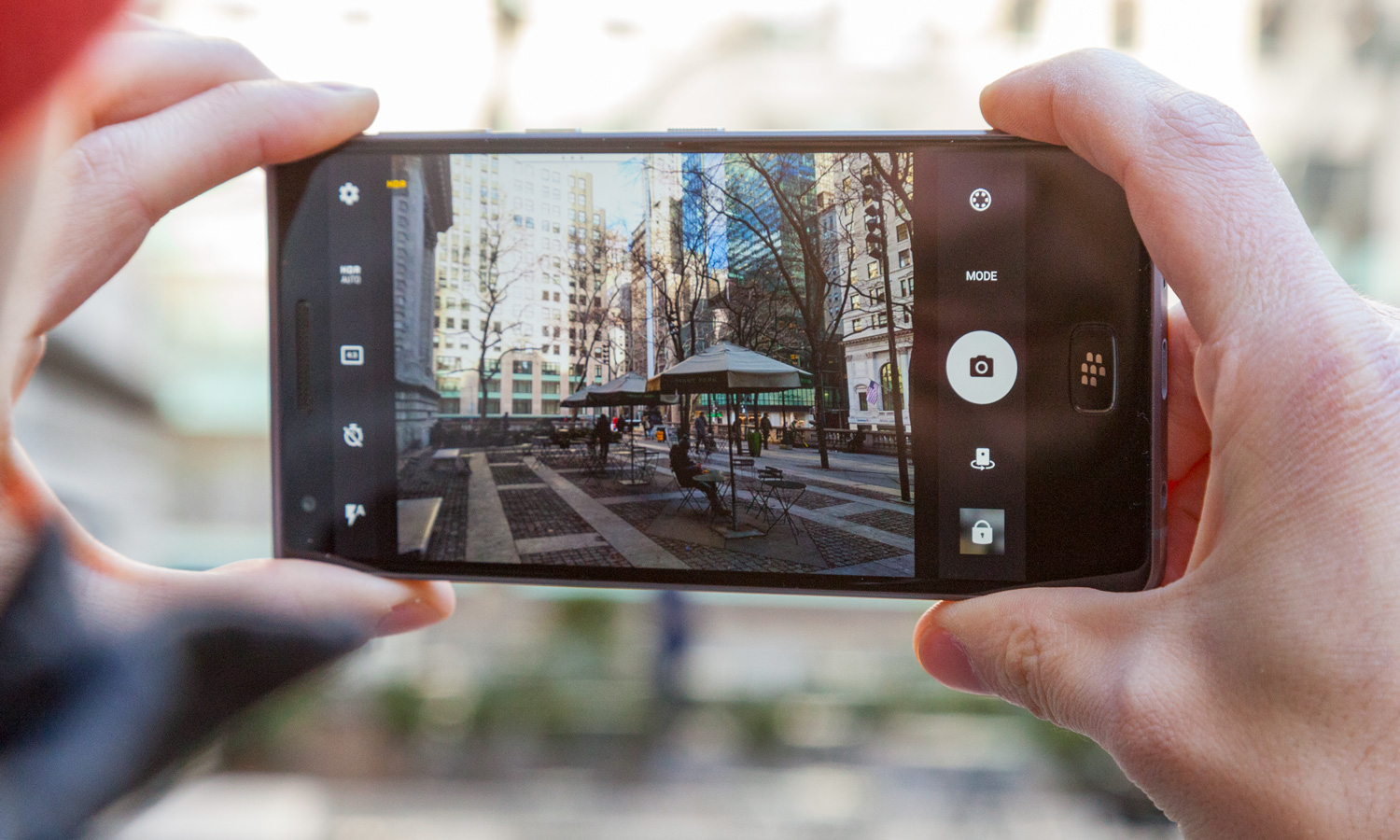
The Motion is equipped with a 12-megapixel, f/2.0 aperture lens on the back and an 8-MP, f/2.2 lens on the front. There's no fancy dual-camera trickery here — the Motion can't manage shallow depth-of-field portraits or optical zoom with its single lens. But this isn't a significant loss, as most dual-camera systems in budget and midrange phones aren't nearly as useful as their higher-priced counterparts.
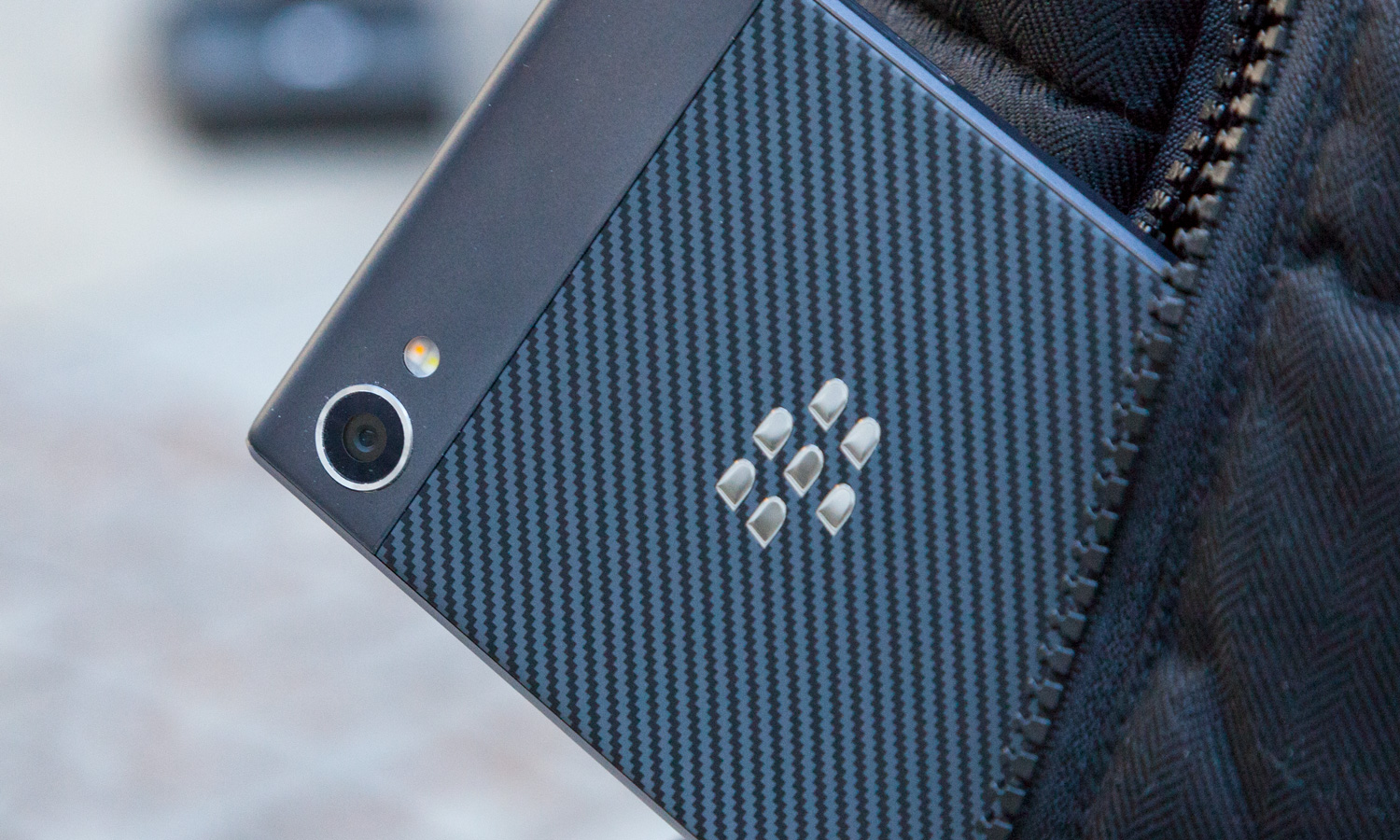
Head-to-head with the $349 HTC U11 Life and its 16-megapixel f/2.0 lens, the Motion's shots were a touch fuzzier on every occasion. Those missing megapixels make a difference when it comes to capturing those finer details, evident in these two portraits of my colleague Shaun.
If you zoom into the U11 Life's rendition, you can actually see the texture of his jacket and shirt. There's more gradation in his skin tone, and the background is blurred a bit more strongly, adding a little drama to the scene. The Motion's portrait isn't poor by any means, but it's also not outstanding given the price of the phone.
These late-afternoon shots taken inside an arched entryway outside our office in New York demonstrate the Motion's penchant for more saturated color and contrast in low light. However, boosting these qualities doesn't necessarily guarantee a better photo, as we can see that the light passing through from the opposite side of the foyer absolutely scorches the ground and blows out the middle of the frame. The HTC doesn't struggle with these highlights to the same degree, though that comes at the expense of a noticeably darker exposure overall.
On a dreary morning in Bryant Park, the Motion held its own against the U11 Life, but the BlackBerry's unnaturally warmer tint produced hues in the chairs and umbrellas that were louder than they should have been. A comparison between the front-facing cameras in both phones produced similar results.
Finally, users may appreciate the Motion's secret party piece: Locker Mode. Locker Mode allows you to use the phone's fingerprint sensor as a shutter button, which also encrypts the image. To view it later, you'll have to scan your fingerprint again. Whether you're entrusted with classified documents on a regular basis or lead a salacious private life, the feature should come in handy.
Bottom Line
Despite its uninspired looks, there's actually a lot under the surface that differentiates BlackBerry's latest smartphone from the horde of budget options available to Android users. But is the premium worth it?
The Motion has a great display, a solid camera and a decent processor — but so do many other handsets. The Moto G5 Plus, the Honor 7X, and the HTC U11 Life deliver all of those for anywhere from $100 to $250 less. If it's battery life you want, the Moto E4 Plus and the Asus ZenFone 4 Max clocked about 15 hours each in our testing, and still allow you to keep $250 in your pocket.
The only reason you'd opt for the Motion over any one of those phones, then, are BlackBerry's software and security enhancements. Are they worth spending twice as much? It depends on who you are and what you're using the phone for.
If you're a business customer, you'll likely appreciate the Motion's built-in malware-monitoring software, deep-rooted encryption, rapid adoption of Google's monthly security patches and the Productivity Hub. For everyone else, though, this BlackBerry is yet another very specialized phone with a very discerning user in mind.
Credit: Shaun Lucas/Tom's Guide
Adam Ismail is a staff writer at Jalopnik and previously worked on Tom's Guide covering smartphones, car tech and gaming. His love for all things mobile began with the original Motorola Droid; since then he’s owned a variety of Android and iOS-powered handsets, refusing to stay loyal to one platform. His work has also appeared on Digital Trends and GTPlanet. When he’s not fiddling with the latest devices, he’s at an indie pop show, recording a podcast or playing Sega Dreamcast.
